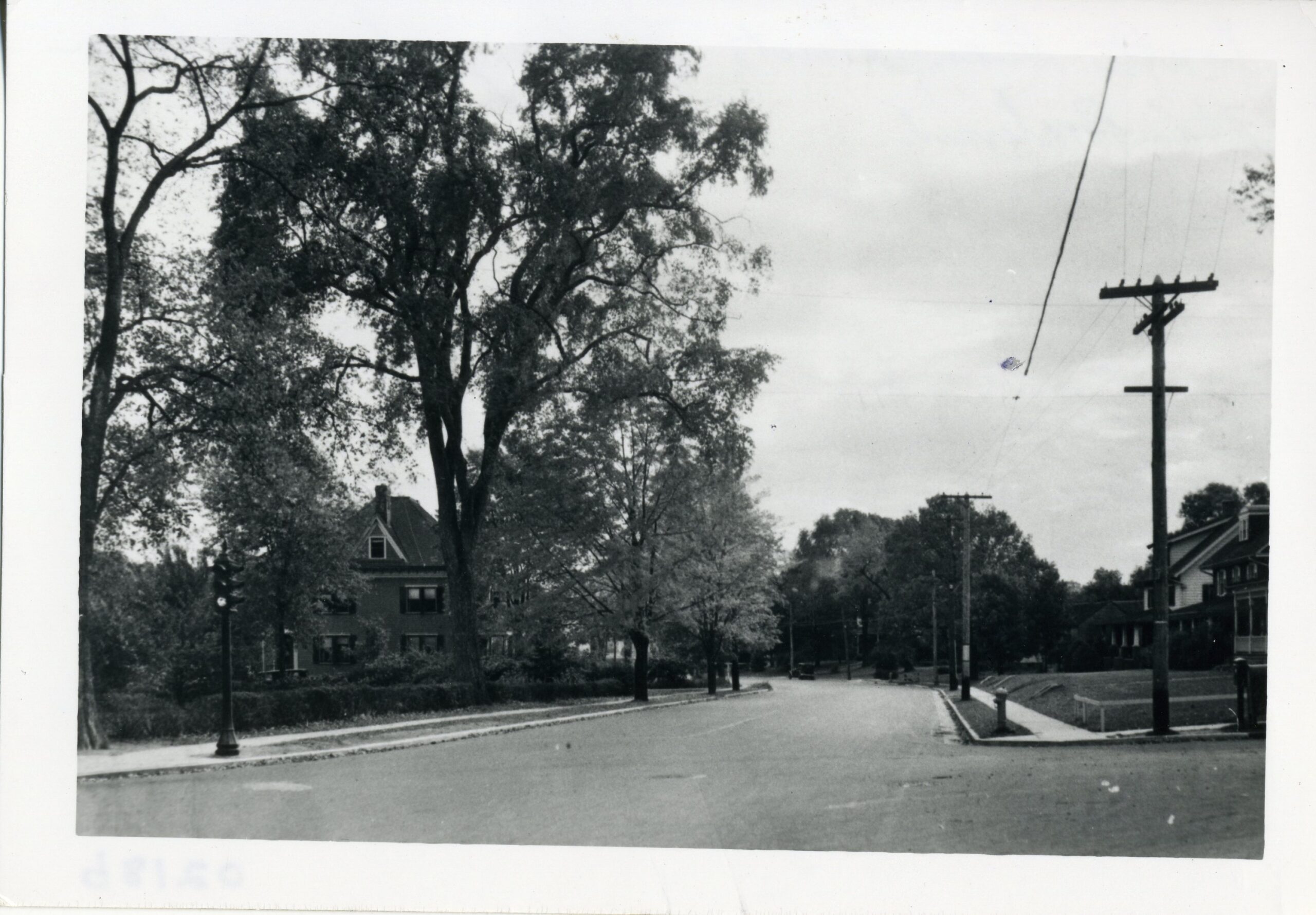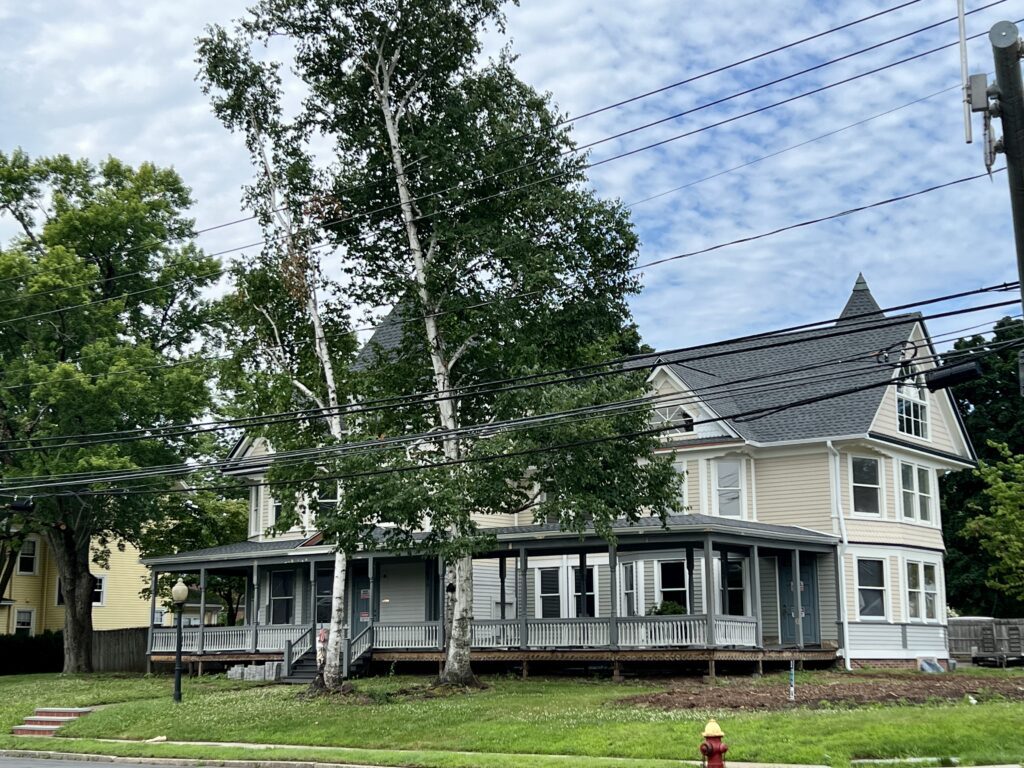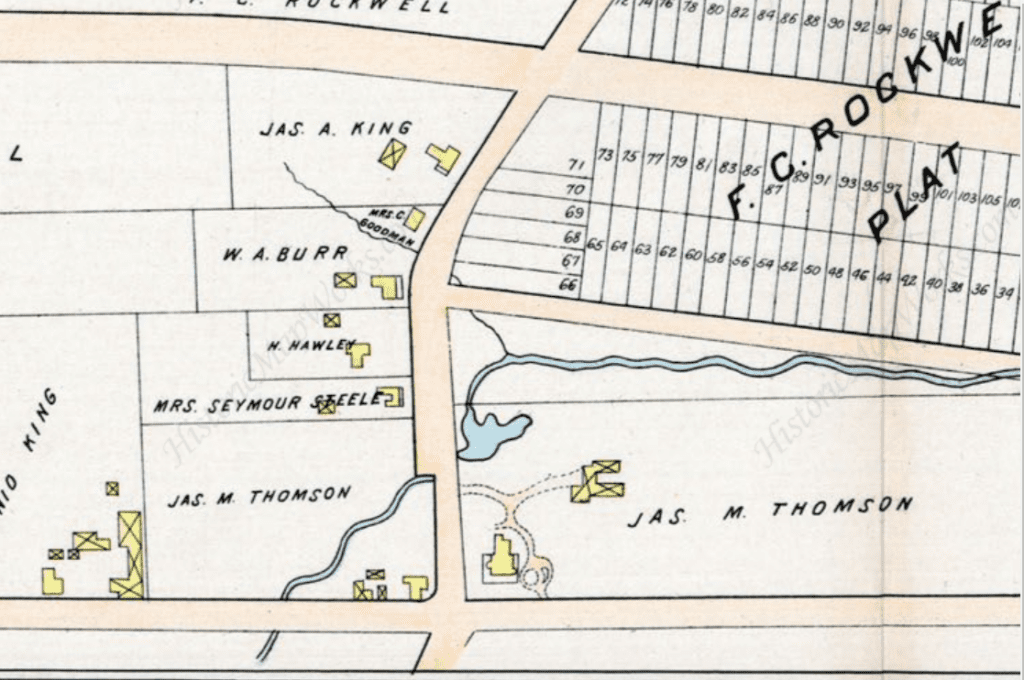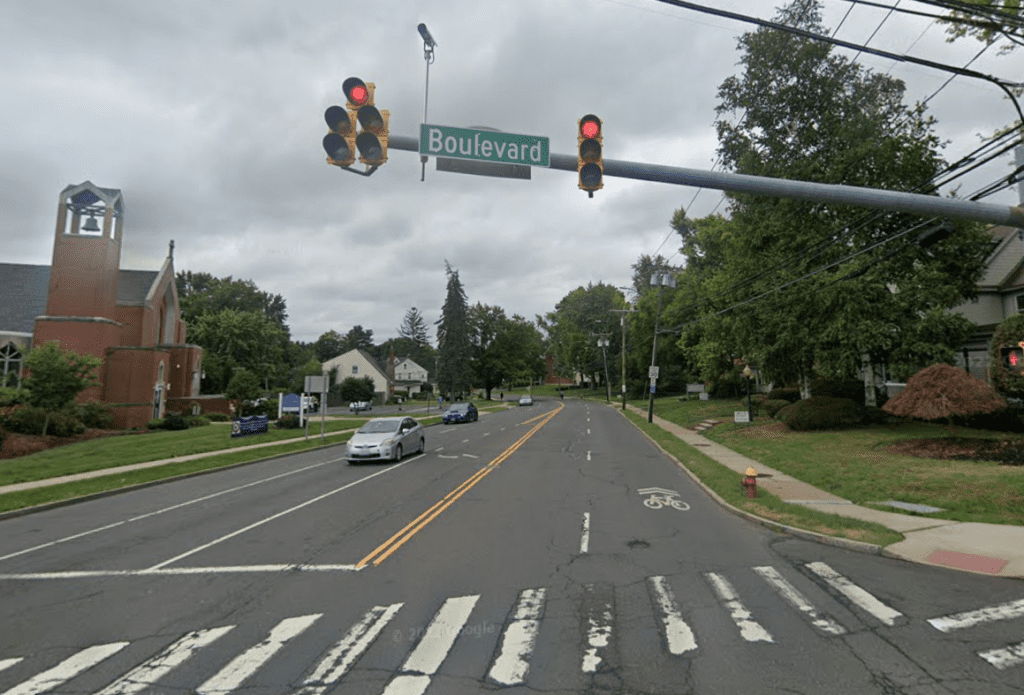From the West Hartford Archives: South Main Street Looking South from Boulevard

Audio By Carbonatix

South Main Street looking south from Boulevard. Photo courtesy of Noah Webster House & West Hartford Historical Society
Historian Jeff Murray takes a look into West Hartford’s past to uncover some surprising information, stir up some memories, or reflect on how much life has changed – or hasn’t changed at all. Enjoy this week’s ‘From West Hartford’s Archives’ …
By Jeff Murray
This photograph shows South Main Street looking south from Boulevard. The east side (left) of South Main Street was bought up by Frederick C. Rockwell in 1895-1896 for this ambitious Boulevard project, while the west side (right) of the street was occupied by a number of houses, all from different eras.
At the southwest corner of Boulevard and South Main Street was the farm of James A. King, whose father had owned the land since at least West Hartford won its independence from Hartford in 1854. His land extended back a few lots along the south side of Boulevard and was one of the few stretches that were never sold to Rockwell for his Boulevard project. Instead, King expanded his holdings and divided the land into lots through the 1910s by himself.
He offered to move an old colonial house that had fallen into disrepair on South Main Street to his own property (it was remodeled and still stands at 1699/1701 Boulevard). His own house at 91 South Main Street was added onto and renovated extensively over the years. He built another house just south of the corner at 95 South Main to rent out.

Current view of 91 South Main Street, which is being renovated to become the new offices for RisCassi & Davis. Photo credit: Ronni Newton
His wife Eva was of prominent West Hartford stock as well – she was born in the north end of town in 1868 to Seymour Steele and Caroline Loomis just off the road named after her father’s lineage. Eva’s mother lived as a widow for over thirty years just south of the King house on South Main Street until the late 1920s. Her grandfather Sherman was one of the petitioners for West Hartford to be independent and her great-aunt married into the Griswold family. Eva’s marriage to James King just consolidated the family connections in the Center.
Nestled in between the family homes on the west side of South Main Street was an old saltbox colonial house on an outlet of Trout Brook. Chester Goodman and his wife Maria lived here for many years. Chester, a farm laborer, petitioned as well for the independence of West Hartford in 1854. After widow Maria died in Middletown in 1915, the house passed to her daughter Clara until the 1930s when it was sold out of the family to Frederick C. Cook and was repaired. The front and sides of the house, with a protruding second floor, was shingled and kept in its natural wood color. His wife Sadie lived there until her death in 1964, marking the last to live in the house.
Soon after her death, the West Hartford Republican Town Committee asked for a special exception to the zoning regulations to use the house as the headquarters for a year. A few years later, the house was replaced by the apartments there today.
Out of view, just past the curve, was 109 South Main Street, the house of 73-year-old Deacon Henry Dwight Hawley, built in the summer of 1901. He lived there for just six months before his death in 1902 from a quick run of pneumonia. His son Charles owned a significant amount of land along the north side of Sedgwick Road and it was his land that the Town of West Hartford bought in the 1920s for Sedgwick Middle School.
The Hawley house on South Main Street was occupied by the family for four decades and was the site of the Apple Orchard Tennis Club (imagine a tennis court in their backyard) under its president Flora, Henry’s daughter. In the 1950s, the house was used as a real estate office until 1968 when this house too was replaced by apartments.

Map of West Hartford in 1896 – the King and Steele families occupied houses on the west side and Rockwell’s lots occupied almost all of the east side.
Frederick Rockwell’s Boulevard plan subdivided the land on both sides into individual lots to be sold to speculators and future homeowners. This section on the south side covered lots 18-71 and then every other lot between 73-123. These sold fast at the auction in the summer of 1896 and within a few years, the east side of South Main Street had two houses, one at the corner by Charles Geer of the Hartford Theological Seminary and the other for Frank C. Benedict at 96 South Main Street.
The latter is the house seen on the left side in the photograph. Benedict had bought up a ton of land at a new suburban real estate development named West Hartford Heights between Whitman Avenue and Fern Street. In 1916, he sold the house to Frederic Hyde Forbes, a longtime cashier at the Connecticut General Life Insurance Company until his death in 1928. Afterwards, the family sold the house to F. Cheyney Beekley, who had moved here from Glastonbury.
Beekley was one of the pioneers of radio communication and taught shortwave communication at Cornell University during World War I with the Army Signal Corps. He was an inventor and held patents for electro-mechanical and data storage uses. He was involved in the development of noise-canceling microphones, which were used during World War II. He formed the West Hartford Printing and Lithographic Company in the 1930s, headquartered in the old Center School building on North Main Street. It became the only printer in the Hartford area to supply business forms.
After his son W. Mason Beekley took over, the company specialized in paper products for the hospital market, supplying charting sheets. They further specialized in the 1980s with disposable medical devices, like skin markers for radiological imaging. Today, Beekley Corporation is based in Bristol.
Alongside F. Cheyney Beekley was his wife Aline Fisher, who graduated from Smith College in the class of 1925 and became the first woman stockbroker in Connecticut. At their house on South Main Street, she hosted meetings of the Hartford branch of the Women’s International League for Peace and Freedom in the late 1930s. This organization was an extension of the efforts during World War I to establish a meaningful and lasting peace among the world’s nations.
She continued to stage meetings there even after World War II broke out. By 1941, discussions revolved around the future immediate aftermath of the war and the formation of a potential “world government”. After they moved away in the mid-1940s, it was occupied by a number of other families before the house was removed for the parking lot of Bethany Lutheran Church.
Finally, no discussion of this section of West Hartford would be complete without a mention of Meadowbrook Road, just past this point. Part of Frederick Rockwell’s Boulevard plan, it was originally named after his daughter Vera. Vera Street was in line with the Trout Brook, so flooding was prevalent. In 1903, a concrete culvert was built to take storm water accumulating at the corner of South Main Street and mitigate some of the impacts of the brook.
The Thomson family, who owned a lot of the land on both sides of Park Road at South Main Street, bought up some of the lots from Frederick Rockwell on Vera Street and built a large greenhouse. W. Wallace Thomson managed the greenhouses through the 1930s. In the fall of 1927, the Town changed the name of this section of Vera Street to Meadowbrook Road to avoid confusion with the other section of Vera Street east of Trout Brook Drive. The fact that it was separated by woodland and water had caused trouble for too long – telegrams and other deliveries had been delayed because deliverymen could not find the right house numbers.
Meadowbrook Road was home to an eccentric hermit who maintained a makeshift shack on the south side of the road. “Whistling John,” as he was known, was well-known to neighbors for nearly 30 years. He died in 1933 at the age of 81 just a few years after the townspeople pitched in to build him a cabin on Meadowbrook. After his death, almost the entire road was filled in with new houses through the end of the 1930s.
This look of South Main Street off Boulevard can open a window to a history of the entire area. It was a collection of old colonial houses, family homesteads, ambitious real estate developers and early suburbia, modern land management, Great Depression-era homes, and the transition to post-WWII apartments that accommodated the surge in demand for housing in places like West Hartford.

Current view of South Main Street looking south from Boulevard. Google Street View
Jeff Murray was born and raised in West Hartford and has been involved with the Noah Webster House & West Hartford Historical Society since 2011 when he was a high school student and won the Meyer Prize for his essay on local history. Jeff routinely volunteers as local history researcher uncovering information for numerous museum programs such as the West Hartford House Tour and West Hartford Hauntings. Jeff works as a data analyst at Pratt & Whitney.
Like what you see here? Click here to subscribe to We-Ha’s newsletter so you’ll always be in the know about what’s happening in West Hartford! Click the blue button below to become a supporter of We-Ha.com and our efforts to continue producing quality journalism.



